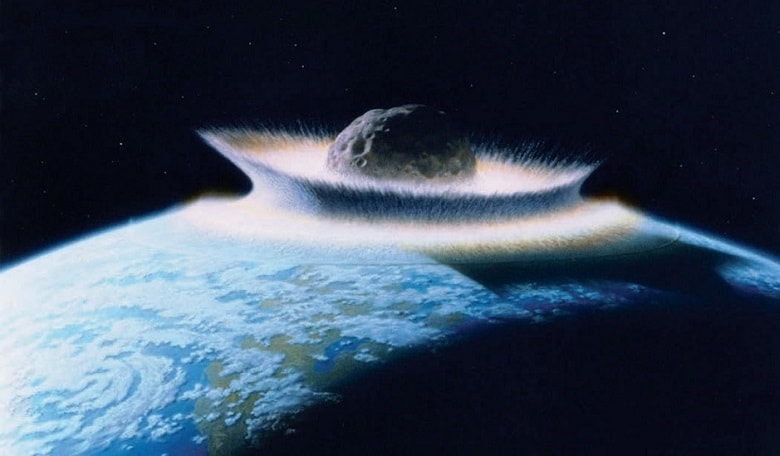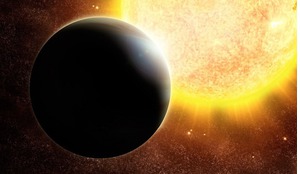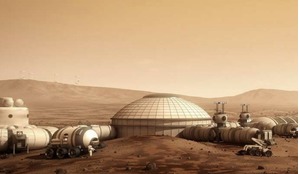A the end of the last century it was conclusively shown that a collision with an asteroid or a comet could lead to a partial or even total destruction of our planet’s biosphere. Collisions in space of various near- Earth objects (or NEOs) are frequent. Thanks to our planet’s atmosphere, objects smaller than about 10 metres in diameter burn up in the atmosphere, and thus are harmless. A collision with a larger body, however, could have very serious consequences.
If the Earth were to collide with an object of about a kilometre in diameter, the energy released would be similar to a combined explosion of all the world’s nuclear weapons. Computer modelling has demonstrated that the release of so much energy would lead to catastrophic consequences for the planet, equivalent to a ‘nuclear winter’.
The reliability of such modelling was verified in 1994 when pictures were received of the effect of the collision of fragments of the Shoemaker-Levy 9 Comet with Jupiter. They showed that the area of the resulting catastrophe in Jupiter’s atmosphere covered an area the size of the Earth.
Over the last 600 million years there have been some 60 collisions with objects with a diameter of over 5km, which have led to catastrophes of a global nature. One of these occurred 65 million years ago in the area of the Yucatan Peninsula. This impact caused the extinction of about 75 per cent of all animal and plant life, including the dinosaurs.
Collisions with objects measuring from a few hundred metres up to a kilometre can happen every few thousand years, and lead to regional disasters. One of these took place about 12,900 years ago, when the nucleus of a comet exploded a few kilometres above North America. As a result of this explosion, the biosphere of the continent was burned up.
Local disasters, caused by objects from a few dozen to hundreds of metres across, can occur every few decades. The zone of destruction may be equivalent to the size of a major city or even a small state. Examples of these are the Arizona and Tunguska meteorites.
In the state of Arizona in the USA lies the Barringer Crater, which measures some 1.3km across and is 170 metres deep. It was formed around 50,000 years ago by an asteroid made of iron and nickel, which was about 40-60 metres in size and weighed around 300,000 tons.
The Tunguska meteorite exploded over the Siberian taiga on 30 June 1908. The explosion was of a magnitude of between 10 and 100 megatons. It destroyed a forested area of about 2,000 sq km and started fires in the taiga which raged for two years.
So far in the 21st century there have already been six such incidents: • 5 July 2002: an explosion of a huge fireball in the sky over Ukraine, near the city of Dnepropetrovsk (wrongly interpreted initially as the shooting down of a passenger aircraft by a surface-to-air missile); • 24 September 2002: in the basin of the River Vitim in Siberia there was an explosion estimated at 0.2 megatons. Around 100 sq km of the taiga was affected; • 28 September 2003: one person died and 20 others were injured, and damage was caused to property in the state of Orissa in India by a fragment of a massive meteorite; • 7 June 2006: there was an explosion in the Norwegian mountains, similar in magnitude to the atomic bomb that was dropped on Hiroshima (though not radioactive); • 15 September 2007: an explosion near the village of Carancas in Peru caused a crater with a diameter of 30 metres and six metres deep; • 15 February 2013: the explosion of the Chelyabinsk Meteorite, with a force of around half a megaton, injured more than 1,600 people in the Russian city of Chelyabinsk in the Urals Region. It caused damage estimated at around one billion roubles (approximately $30m).
Planetary defence
One way of guaranteeing the safety of the planet could be the creation of the ‘Citadel’ international planetary defence system. The system would be made up of two stages: the rapid reaction phase, Citadel-1; and the longterm reaction phase, Citadel-2.
The rapid reaction phase forms the basis of the system. At present, it is only sufficiently large asteroids – those measuring more than a few hundred metres – that we can spot years or even decades before they hit the Earth.
Tracking smaller asteroids, of a size from a few dozen metres across (like the Chelyabinsk one) to a few hundred metres, we may be able to do only as they are approaching the Earth – a few days or perhaps months before the collision. Such objects account for about 99.9 per cent of all asteroids coming close to Earth.
Even if we were able to spot all asteroids in advance, this would still not fully guarantee our safety. Any asteroid that may not pose a threat to us could suddenly change its trajectory if it collides with a smaller NEO, which we can’t even see. We can call this the ‘Brownian motion of asteroids’. This could cause an asteroid to be sent in the direction of Earth.
The likelihood of such an event happening isn’t great. But if we want to guarantee our security from accidental collisions, we have to be ready for objects that don’t currently pose a danger to us suddenly becoming dangerous. The only way we can do this is by creating the rapid reaction phase of a planetary defence system. This must be capable of detecting a cosmic threat from just a few days before or longer.
This Citadel-1 phase can be created in a short space of time and at minimum expense, using missile and nuclear technology that we already have. The rapid-reaction phase should include: • an Earth-based space observation service, especially designed for tracking and studying dangerous objects; • two elements of a reconnaissance and interception service, ‘East’ and ‘West’, designed to determine the characteristics of the dangerous object and the defence against it; • Control from both East and West.
Besides this, the rapid-reaction phase should include reserve services: • a service for predicting the likely area of impact of the NEO and the consequences of a collision; • a regional defence service based on aerospace defence.
The space observation platform would consist of observation spacecraft equipped with telescopes, which would operate within the visible and infra-red spectrum. Such spacecraft could operate in Earth orbit, interplanetary orbit or, in time, be based on the Moon. The space observation platform helps to guarantee that dangerous NEOs are picked up a few days before any collision, even if they are coming from the direction of the Sun.
This is something which Earth-based telescopes cannot do. For a more detailed examination of the object, small reconnaissance spacecraft will be launched, weighing between 100kg and 200kg.
The reconnaissance spacecraft will obtain information about the NEO’s trajectory and physical characteristics, which will be essential for designing a computer model of the dangerous asteroid or comet. On the basis of the information received, a system for apprehending the object can be established.
By far the preferred method of defence against dangerous NEOs will be by deflecting them away from an Earth-bound trajectory. However, it may take even more energy to divert the object from its path than it would to destroy it. So the most likely means of defence against a dangerous NEO will be to destroy it. For this, interceptor spacecraft will be equipped with kinetic or nuclear weapons.
In order to destroy an asteroid that is 100 metres across you would need a one-kiloton nuclear bomb. Asteroids that are a few hundred metres wide could be blown up with a megaton nuclear device. Today’s rockets are more than capable of carrying such an explosive device into space.
On the basis of the rapid-reaction phase it may be sufficient swiftly to form the long-term reaction phase to deal with large, dangerous NEOs. Dealing with such objects with the help of the long-term reaction phase will be similar to the way in which interplanetary expeditions have already been carried out on many occasions to asteroids, comets and other bodies in the solar system. In such cases, the interceptor vehicles are more likely as a rule to try to knock the objects off their trajectory towards the Earth.
In order to create the long-term reaction phase it will be essential to develop new and more powerful means of launching spacecraft, such as with nuclear rocket motors. This will cost more and will take longer to develop. To do this, of course, and in order to ward off the threat from space, resources need to be brought together from all round the world.
In the front line there need to be states which already have the facilities for launching space rockets and nuclear capability: Russia, the USA, the European Union, China, Japan and India. But in order to organise this work quickly, it is vital that mankind first works out a mobilisation plan, in case a threat arises.
The defence of the Earth is a question which concerns the whole of mankind, thus it must be solved by joint efforts and with the resources of the whole world. What’s more, a whole host of problems have to be solved.
Scientific and technical problems
A huge number of scientific and technical problems will have to be overcome for the creation of a planetary defence system. As the planning of the concept has shown, there should be no problem creating the rapid-reaction phase. All of the fundamental components are already available, such as rocket and nuclear technology. The creation of the long-term reaction phase is a different matter. A great deal of scientific and technical problems need to be solved.
Questions of international law
There are numerous important legal issues that need to be overcome in the creation and operation of the planetary defence system: 1. The Notification Dilemma: the first absolutely crucial condition, which will decide the effectiveness of the defensive measures to be taken, will be the timely warning of a threat to all the relevant states and international organisations. It will be essential to ensure a reliable passage of information, and to exclude any possibility of a delay. The creation of the space observation segment would make it comparatively easy to organise the independent reception of information from spacecraft at various points in a number of areas of the globe. 2. The Alert Dilemma: what if we are threatened by a global catastrophe and we can’t avoid it? Do world leaders tell their people about ‘the end of the world’? 3. The Applications Dilemma: could the new technology be used for military purposes? Could the technology created for the interception and destruction of an NEO be used, for example, to create components for anti-missile, kinetic or other types of weapons? 4. The Non-Use Dilemma: if the system is controlled by one group of states could they refuse to use it for the defence of other states? Could they use the situation to put pressure on these other states in order to change the geopolitical situation?
There will, of course, be many other problems. They should be included in an international agreement.
Financial challenges
Preliminary estimates suggest that the cost of creating the rapid reaction phase will be around $15-20 billion, and that the annual funding of the system of planetary defence will be $1-2 billion. This could be covered by taking one thousandth of the world’s combined military budgets.
Miscellaneous problems
A situation could arise where, even if the system were in place, we may not be able to avoid a catastrophe. Therefore, we need measures which, in the event of a total disaster, will ensure the survival or even the re-establishment of man as a species and also for the biosphere of the Earth. We need to preserve, too, all those values which our civilisation has created.
If it were to prove impossible to avoid a global catastrophe, a base could be set up on the Moon as a kind of second ‘Ark’ in order to save a small colony of people from Earth. Once the after-effects of the catastrophe on Earth had passed, they could set out to re-populate the planet.
A collision with the Earth by asteroids or comets could bring about the partial or even the total destruction of mankind and the Earth’s biosphere. This makes it essential to take measures to deal with – or at least minimise – the consequences of such a collision.
Citadel-1 could be created in five to seven years. This would give a guaranteed defence for the Earth from the threat of asteroids and, to some extent, comets. Once this rapid reaction phase has been created, a long-term reaction phase could be created, to defend against large asteroids and comets by tracking them well in advance of any collision.
Before this can be done, the main obstacle to be overcome is the moral problem of making sure that everyone on the planet is aware of the threat from space, and that we have a shared responsibility to preserve mankind and the biosphere of the Earth.
The threat from space is a test of mankind’s ability to solve the global problems that it faces. If we can do this, then we shall be laying down a foundation for the successful solution of all of the economic, social, ecological and many other problems facing us. And the creation of the system of planetary defence could be the catalyst for the development of a wide range of technologies. This will lead not only to a system of defence, but to the development and integration of nations.














